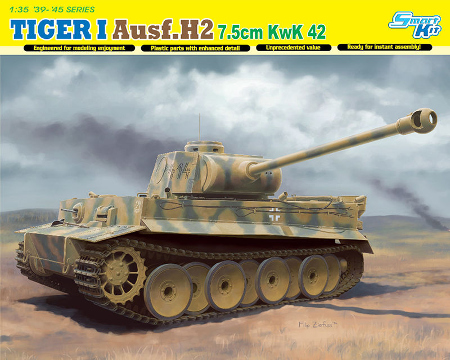
Dragon 1/35 Tiger I Ausf.H2 7.5cm KwK 42
By Jacob Russell
The Tank
The Tiger I is probably the most famous and feared tank of the Second World War. It was designed as a "breakthrough" weapon, and it featured extremely thick armor and an 88mm KwK 36 cannon. For over 2 years there wasn't a single Allied tank able to match it on the battlefield. Its dimensions were impressive: it was over 27 feet long, over 12 feet wide, and it weighed over 50 tons.
The hull and superstructure armor were 100mm thick, the hull sides were 60mm thick and the superstructure sides and rear plate were 80mm thick. Its heavy weight necessitated interleaved road wheels on an overlapping torsion bar suspension, in order to achieve the proper ground pressure. A five man crew operated each Tiger I.
Henschel und Sohn of Kassel built 1,354 Tiger I tanks during its two year production run from July 1942 to August 1944. Maybach provided the 650 hp HL 210 P45 V-12 gasoline engine. The more powerful 700 hp HL 230 P45 replaced the HL 210 at the end of the 1943.
The Tiger was subject to continuous running changes to components such as its turret, mantlet, commander's cupola, crew hatches, etc. which led to variant designations such as "Early," "Mid" and "Late." It's very important to have access to photographs of the tank you wish to model when they're available, in order to confirm the myriad of detail differences from one tank to another.
The Model
The kit comes in Dragon's customary cardboard box with a nice rendering on top. This is a complex kit as you might expect. It consists of approximately 301 parts. 293 of these are injected molded on 19 sprues, plus the hull. 21 parts are clear plastic. 170 parts are surplus and go unused. A single photo etch fret contains 4 additional parts. There are 2 "DS" tracks, 2 metal parts and a small decal sheet. All of the parts are bagged. The molding of these parts, with Dragon's new "slide mold" technology is impressive.
The hull in particular comes in for high praise with the superb detail on the underside which, of course, no one will see... The gun barrel has a long seam that will be easy to clean up. You might opt for an aftermarket turned brass barrel in the interests of saving time, given how many hours you'll spend removing the smallest parts from the sprues. The photo etch parts are radiator screens, and these are well done. The weld seams on the upper hull are convincing, albeit a bit too uniform in execution. There is very convincing texture on the upper hull, just behind the radiator screens. The tools are extremely well done. There are two different styles of Feifel air cleaners to choose from. Dragon has greatly simplified the wheels by molding them into linked sets with connectors that overlap each other. I think this will really appeal to a novice modeler intimidated with the prospect of assembling 48 individual wheels...
The instructions are what you expect to find in a Dragon armor kit. They are well illustrated, include a parts map, and they feature a logical build sequence. Color callouts are for GSI Creos' Acqueous and Mr. Color lines, and Testors Model Master enamels. There is a very small, well printed decal sheet that includes national insignias and turret numbers. The kit has options for 3 different tanks:
1) 13.Pz.Regt, LAH, Prokhorvka, Operation Citadel, July 1943. Dark Yellow with Green field-applied camouflage.
2) s.Pz.Abt. 101, Zhitomir, November 1943. Dark Yellow with Green/Brown field-applied camouflage.
3) Pz.Abt.503, 1943. Dark Yellow with Green field-applied camouflage.
It's worth mentioning that all of the above are fictitious: the Tiger I never saw combat with the Panther turret...
Conclusion
Noted armor modeler Cookie Sewell has pointed out that the "H" designation refers to the fact that the kit comes with a Henschel turret, which was actually intended for the Panther tank. This turret has the Panther "A" style mantlet and "dustbin" style commander's cupola.
This is a very well executed kit of a tank that never saw combat. It's therefore somewhat of a mixed bag, albeit a well executed one. I would like to thank Dragon Models USA for the review sample.
References
A) Online:
Cookie Sewell's review of this kit on Missing Lynx: https://www.missing-lynx.com/reviews/german/dml6683reviewcs_1.html
B) In Print:
1) Tiger In Action, Armor Number 27, by Bruce Culver, Squadron/Signal Publications, 1989
2) Modeling the Tiger I, Osprey Modeling #37, by Gary Edmundson, Dinesh Ned, David Parker, Darren Thompson and Steve van Beveren, Osprey Publishing, 2007
